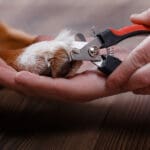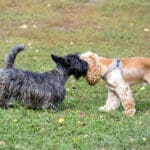Tips on how to determine when to use a dog muzzle
Muzzles and the dogs who wear them face an unfortunate stigma; however, muzzles aren’t only for aggressive breeds or poorly trained dogs. They can be used as a safety mechanism to protect those who care for them and other dogs.
A dog muzzle is a mask-like device placed over the snout of a dog to prevent the dog from biting other dogs or humans. When the muzzle is fitted properly, the dog should be able to pant, eat, and drink while wearing the muzzle.
It’s important to note that muzzles should never be used as a punishment for dogs. So, how do you avoid the need to use a muzzle regularly? Proper training and socialization are key to preventing bad-mannered pups.
Dogs that have not been properly handled or introduced to other people or animals will be prone to behavioral problems. These behavioral problems are simply a natural survival and defense mechanism; some problems result in the need for muzzles and other safety measures.
When to Use a Dog Muzzle
Dog muzzles have an unfair association with aggressive, dangerous dogs; however, most experts agree that there are certain situations that warrant their use for the dog’s safety as well as others.
All muzzles should be used as a temporary safety precaution and always under the supervision of the dog owner. Here are some situations that make the use of a muzzle appropriate to protect the dog and others.
In emergency situations
During an emergency, an injured or frightened dog is much more likely to bite or snap at a threat. It’s a natural behavior no matter how uncharacteristic it may be for your dog.
It’s important to remember that dogs can’t communicate as humans do; therefore, barking, growling, and sometimes biting is the only way they can tell others they are scared or hurt.
In the event that your dog is injured, it’s possible they might lash out and bite anyone who tries to treat them. Especially, if the animal needs to be moved, using a muzzle will keep those safe who are caring for the animal.
History or risk of biting
If your dog has a history of biting or has bitten another animal or human in the past, consider using a muzzle when they are in unfamiliar social situations.
Even if your dog has never lashed out before, behaviors like lunging, barking, or growling could indicate that the risk for biting does exist. While you are out, keep an eye on the behaviors of your dog. If they indicate they are stressed or uncomfortable and begin to exhibit signs of aggression, remove them from the situation immediately.
Remember, a muzzle isn’t to be used for punishment or to avoid the root of the problem. It’s simply a temporary tool for use while you work on rectifying their behaviors with your vet or a trainer.
Grooming or Vet visits
More commonly, muzzles are used during grooming trips and veterinary appointments so the professionals can do their jobs more effectively.
Generally, dogs feel uncomfortable during vet and grooming sessions where they are exposed to unfamiliar people and new experiences. Even if your dog is properly socialized, it may react aggressively to a situation that makes them uncomfortable.
Check with your vet and groomer to see if they provide muzzles on-site or if you need to bring your own.
Breed-specific legislation and dog muzzles
Some states have breed-specific legislation, requiring certain breeds to muzzle up when not on private property.
Despite the highly controversial nature of this legislation, these more “dangerous” breeds are required to wear muzzles in public. If you have a pit bull or pit bull mix, check your city laws to see if your dog needs to muzzle up before heading to the park.
A properly muzzled dog is a sign of a responsible pet owner who takes the public health of other dogs and humans seriously. There are many situations that warrant muzzling a dog; it’s important to understand how to use them properly to minimize stress on your dog.
If you have concerns about your dog’s behavior, give our office a call to schedule an appointment.






